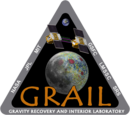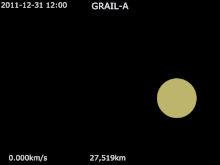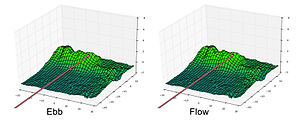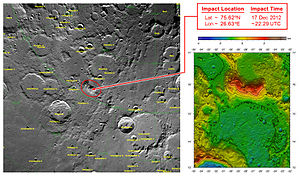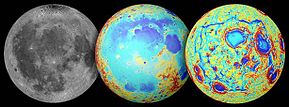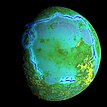
Mare Orientale is a lunar mare. It is located on the western border of the near side and far side of the Moon, and is difficult to see from an Earthbound perspective. Images from spacecraft have revealed it to be one of the most striking large scale lunar features, resembling a target ring bullseye.

Mare Moscoviense is a lunar mare that sits in the Moscoviense basin. It is one of the very few maria on the far side of the Moon. Like Mare Marginis, this mare appears to be fairly thin. However, it is clearly centered within a large impact basin. It is also much lower than either the outer basin floor or the farside highlands.

In lunar astronomy, libration is the cyclic variation in the apparent position of the Moon perceived by Earth-bound observers and caused by changes between the orbital and rotational planes of the moon. It causes an observer to see slightly different hemispheres of the surface at different times. It is similar in both cause and effect to the changes in the Moon's apparent size due to changes in distance. It is caused by three mechanisms detailed below, two of which cause a relatively tiny physical libration via tidal forces exerted by the Earth. Such true librations are known as well for other moons with locked rotation.

The Discovery Program is a series of Solar System exploration missions funded by the U.S. National Aeronautics and Space Administration (NASA) through its Planetary Missions Program Office. The cost of each mission is capped at a lower level than missions from NASA's New Frontiers or Flagship Programs. As a result, Discovery missions tend to be more focused on a specific scientific goal rather than serving a general purpose.
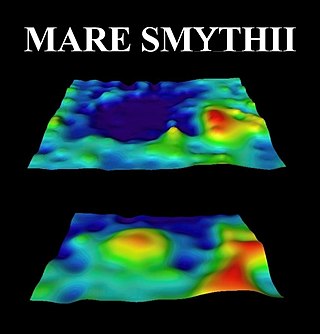
In astronomy, astrophysics and geophysics, a mass concentration is a region of a planet's or moon's crust that contains a large positive gravity anomaly. In general, the word "mascon" can be used as a noun to refer to an excess distribution of mass on or beneath the surface of an astronomical body, such as is found around Hawaii on Earth. However, this term is most often used to describe a geologic structure that has a positive gravitational anomaly associated with a feature that might otherwise have been expected to have a negative anomaly, such as the "mascon basins" on the Moon.

Lunar Prospector was the third mission selected by NASA for full development and construction as part of the Discovery Program. At a cost of $62.8 million, the 19-month mission was designed for a low polar orbit investigation of the Moon, including mapping of surface composition including Lunar hydrogen deposits, measurements of magnetic and gravity fields, and study of lunar outgassing events. The mission ended July 31, 1999, when the orbiter was deliberately crashed into a crater near the lunar south pole, after the presence of hydrogen was successfully detected.

Hertzsprung is an enormous lunar impact crater, or impact basin, that is located on the far side of the Moon, beyond the western limb. In dimension, this formation is larger than several of the lunar mare areas on the near side. It lies in the northwestern fringe of the blast radius of the Mare Orientale impact basin. Nearby craters of note include Michelson across the northeast rim, Vavilov across the western rim, and Lucretius to the southeast.
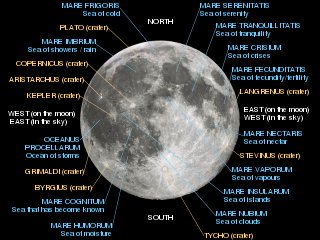
The near side of the Moon is the lunar hemisphere that always faces towards Earth, opposite to the far side. Only one side of the Moon is visible from Earth because the Moon rotates on its axis at the same rate that the Moon orbits the Earth—a situation known as tidal locking.

In astronomy, lunar orbit is the orbit of an object around the Moon.

Maria T. Zuber is an American geophysicist who is the vice president for research at the Massachusetts Institute of Technology, where she also holds the position of the E. A. Griswold Professor of Geophysics in the Department of Earth, Atmospheric and Planetary Sciences. Zuber has been involved in more than half a dozen NASA planetary missions aimed at mapping the Moon, Mars, Mercury, and several asteroids. She was the principal investigator for the Gravity Recovery and Interior Laboratory (GRAIL) Mission, which was managed by NASA's Jet Propulsion Laboratory.

The acceleration due to gravity on the surface of the Moon is approximately 1.625 m/s2, about 16.6% that on Earth's surface or 0.166 ɡ. Over the entire surface, the variation in gravitational acceleration is about 0.0253 m/s2. Because weight is directly dependent upon gravitational acceleration, things on the Moon will weigh only 16.6% of what they weigh on the Earth.

A permanently shadowed crater is a depression on a body in the Solar System within which lies a point that is always in darkness.
Universal Space Network, Inc., or USN is an American company specializing in tracking, telemetry, and control of spacecraft. It is a subsidiary of Swedish Space Corporation, with four main sites and cooperative agreements with many others. USN has been used by commercial satellite operations such as Sirius XM Radio and scientific missions both in low Earth orbit and in orbit around the Moon. USN has offered a 50% discount for their services for competitors for the Google Lunar X Prize.
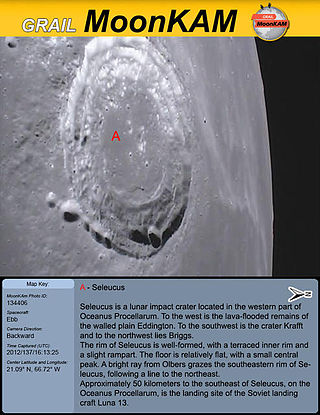
GRAIL MoonKAM (Moon Knowledge Acquired by Middle school students) was part of NASA’s GRAIL satellite mission to map the Moon’s gravity.
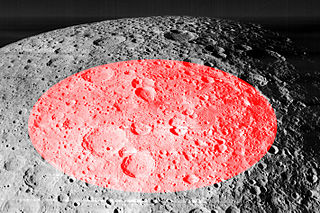
The Freundlich-Sharonov Basin is a Pre-Nectarian impact basin on the far side of the Moon. It is named after the younger craters Freundlich near the northwest margin and Sharonov near the southwest margin. It lies east of Mare Moscoviense basin and northwest of Korolev basin.
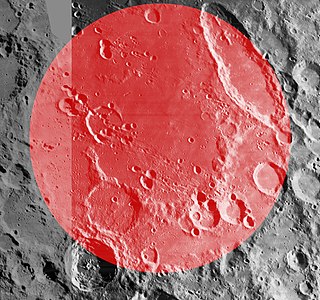
The Schiller-Zucchius Basin is a Pre-Nectarian impact basin on the near side of the Moon. It is named after the elongated crater Schiller at the northeast margin and fresh crater Zucchius near the southwest margin. This basin has received the unofficial designation 'Schiller Annular Plain' among lunar observers.

The Mendel-Ryberg Basin is a Nectarian impact basin on the southwestern limb of the moon. It is named after the crater Mendel on the west margin and the smaller crater Rydberg north of the center of the basin. The basin is due south of the larger, younger Orientale basin, and ejecta and other geomorphological effects from the younger basin have overprinted the older one.
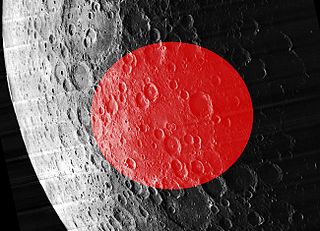
The Coulomb-Sarton Basin is a Pre-Nectarian impact basin on the far side of the Moon. It is named after the crater Coulomb northeast of the center of the basin and the smaller crater Sarton just south of the center. The basin is not obvious on the lunar surface. There are only small fragments of inner rings and a rim, and the most indicative topographic feature is a smooth, low plain at the center.

The Dirichlet–Jackson Basin is a pre-Nectarian impact basin on the far side of the Moon. It is named after the craters Dirichlet and Jackson. It lies to the north of the similar-sized basin Korolev.

The gravity of Mars is a natural phenomenon, due to the law of gravity, or gravitation, by which all things with mass around the planet Mars are brought towards it. It is weaker than Earth's gravity due to the planet's smaller mass. The average gravitational acceleration on Mars is 3.72076 ms−2 and it varies.

